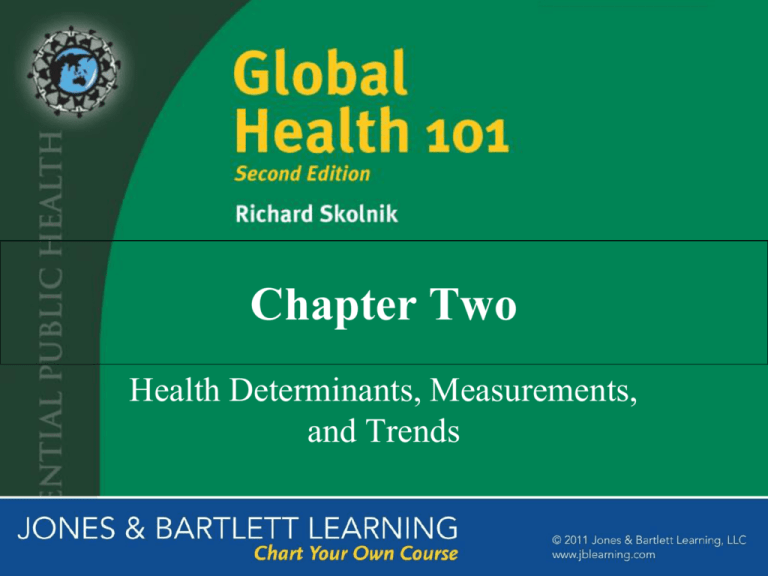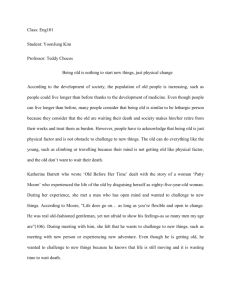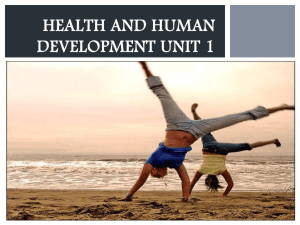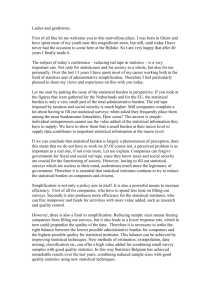Chapter Two - Ohio University
advertisement

Chapter Two Health Determinants, Measurements, and Trends The Importance of Measuring Health Status In order to address global health issues, we must understand: • The factors that influence health status most • The indicators used to measure health status • The key trends that have occurred historically Determinants of Health • The interconnected factors that determine an individual’s health status • Determinants include personal features, social status, culture, environment, educational attainment, health behaviors, childhood development, access to care, and government policy • Increasing attention is being paid to the “social determinants of health” Figure 2.1: Key Determinants of Health Key Health Indicators Health status indicators are useful for: • Finding which diseases people suffer from • Determining the extent to which the disease causes death or disability • Practicing disease surveillance To perform these functions, it is important to use a consistent set of indicators Table 2.1: Key Health Status Indicators Source: Data from the Public Health Agency of Canada. What Determines Health. Available at: http://www.phacaspc.gc.ca/phsp/determinants/ indexeng.php#determinants. Accessed November 19, 2010. Figure 2.2: Life Expectancy at Birth, by World Bank Region, 2008 Figure 2.3: Infant Mortality Rate Figure 2.4: Neonatal Mortality Rate Figure 2.5: Under-5 Child Mortality Rate Figure 2.6: Maternal Mortality Rate Key Health Indicators • • • • • Terms Morbidity- sickness or any departure, subjective or objective, from a psychological or physiological state of well-being Mortality- death Disability- temporary or long-term reduction in a person’s capacity to function Prevalence- number of people suffering from a certain health condition over a specified time period Incidence- the rate at which new cases of a disease occur in a population Key Health Indicators Classifications of Disease • Communicable disease- illnesses caused by a particular infectious agent that spread directly or indirectly from people to people, animals to people, or people to animals • Noncommunicable disease- illnesses not spread by an infectious agent • Injury- include road traffic injuries, falls, selfinflicted injuries, and violence, among other things Vital Registration • Vital registration systems record births, deaths, and causes of death • An accurate system is key to having quality data on a population • Many low- and middle-income countries lack a vital registration system • Developing a system is progress towards understanding and addressing health problems Measuring the Burden of Disease • Twp indicators used to compare how far countries are from a state of good health • Health-Adjusted Life Expectancy (HALE)summarizes expected number of years to be lived in what might be termed the equivalent of good health • Disability-Adjusted Life Year (DALY)- a unit for measuring the amount of health lost because of a particular disease or injury Measuring the Burden of Disease DALY • “Health gap measure,” indicating losses due to illness, disability and premature death in a population • Gives a better estimate of the health of a population than death rate • Accounts for health conditions like mental illness that rarely cause death The Global Burden of Disease Important to understand: • Leading causes of illness, disability, and death in the world • Variations by age, sex, ethnicity, and socioeconomic status • Changes over time Table 2.3: The 10 Leading Causes of Death and DALYs Source: Adapted with permission from Lopez AD, Mathers CD, Murray CJL. The burden of disease and mortality by condition: data, methods, and results for 2001. In: Lopez AD, Mathers CD, Ezzati M, Jamison DT, Murray CJL, eds. Global Burden of Disease and Risk Factors. Washington, DC and New York: The World Bank and Oxford University Press; 2006. Table 2.3: The 10 Leading Causes of Death and DALYs (cont.) The Global Burden of Disease Causes of Death by Region • Higher income countries tend to have a greater burden of noncommunicable disease • Lower income countries to have a greater burden of communicable disease • Africa and South Asia are set apart by their large burdens of communicable disease Table 2.4: The Leading Causes of the Burden of Disease Source: Reprinted with permission from Lopez AD, Mathers CD, Murray CJL. The burden of disease and mortality by condition: data, methods, and results for 2001. In: Lopez AD, Mathers CD, Ezzati M, Jamison DT, Murray CJL, eds. Global Burden of Disease and Risk Factors. Washington, DC and New York: The World Bank and Oxford University Press; 2006:91. Table 2.4: The Leading Causes of the Burden of Disease (cont.) The Global Burden of Disease Causes of Death by Age • Children in low- and middle-income countries often die of communicable disease • HIV/AIDS and TB are among the leading causes of death among adults in low- and middle-income countries Table 2.5: The 10 Leading Causes of Death in Children Ages 0-14, by Broad Income Group, 2001 Table 2.6: The 10 Leading Causes of Death in Adults 15-59, by Broad Income Group, 2001 The Global Burden of Disease The Burden of Deaths and Disease Within Countries In most low- and middle-income countries: • Rural people will be less healthy • Disadvantaged ethnic minorities will be less healthy • Women will suffer from their weak social positions • Poor people will be less healthy • Uneducated people will be less healthy Risk Factors • Risk factor- an aspect or personal behavior or lifestyle, an environmental exposure, or an inborn or inherited characteristic, that, on the basis of epidemiological evidence, is known to be associated with health-related conditions considered important to prevent • Most important risk factors in low- and middleincome countries are malnutrition, high blood pressure and high cholesterol, smoking, and unsafe sex Table 2.8: The Leading Risk Factors for the Burden of Disease, 2001, Low- and Middle-Income and High-Income Countries, Ranked in Order of Percent of Total DALY Demography and Health Population Growth • Majority of population growth will occur in low- and middle-income countries • Put pressure on the environment • Create need for more infrastructure and services Demography and Health Population Aging • Population of the world is aging • Implications for burden of disease because people will be living longer with morbidities and disabilities • Healthcare financing will be affected by change in ratio of working people to those over 65 years Demography and Health Urbanization • Majority of the world’s population lives in urban areas for the first time • Enormous pressure on urban infrastructure like water and sanitation Demography and Health The Demographic Divide • Highest income countries: low fertility, declining populations, aging populations • Lowest income countries: relatively high fertility, growing populations Demography and Health The Demographic Transition • Shift from pattern of high fertility and high mortality to low fertility and low mortality • Mortality declines due to better hygiene and nutrition • Population grows with younger share of population increasing • Fertility declines • Population growth slows and older share of population increases Figure 2.9: The Demographic Transition Demography and Health The Epidemiologic Transition • Shift from burden of disease dominated by communicable disease to burden of disease dominated by noncommunicable disease • Most low-income countries are in ongoing transition so they face large burdens of communicable and noncommunicable disease Figure 2.10: The Burden of Diseae by Group of Cause, Percent of Deaths, 2001 Progress in Health Status • Improvements in raising life expectancy and improving health not uniform across countries • Life expectancy in South Asia and subSaharan Africa lag that in other regions • Life expectancy in Europe and Central Asia changed little due to break-up of Soviet Union • Life expectancy in East Asia has increased dramatically due to rapid economic growth Table 2.11: Life Expectancy and Percentage Gain in Life Expectancy, 19602008, by World Bank Region Looking Forward Economic Development • Economies of low-income countries need to grow in order to invest in health • Impact of economic development will depend on countries investing in areas that improve health such as water, sanitation, and education Looking Forward Scientific and Technological Change • Development of vaccines, drugs, and diagnostics • Country’s ability to adopt these changes will determine their effect on health Looking Forward Climate Change • Impact not entirely clear • Possible migration from places that become inhabitable • Adverse weather • Possible change in populations of disease vectors Looking Forward Political Stability • Necessary for long-term gains in health • Instability causes illness, disability and death as well as breakdown of infrastructure and services Looking Forward Emerging and Re-emerging Infectious Disease • Occurrence and impact difficult to predict • Pandemic flu • Anti-microbial resistance Looking Forward Projecting the Burden of Disease • Substantial changes from 2004 to 2030 • Low- and lower-middle-income countries will shift away from communicable disease • Causes associated with aging will increase in importance • Mental health issues will increase in importance The Development Challenge of Improving Health • Health usually increases as national income increases • Some countries have achieved higher life expectancies than their incomes would predict • This is possible with investments in nutrition, education, good hygiene, and low-cost services that have a high impact such as vaccination programs








